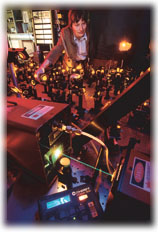Main Menu · Search ·Current Issue ·Contact ·Archives ·Centennial ·Letters to the Editor ·FAQs

Light at 38 M.P.H. As a laser beam travels through the apparatus, Lene Hau adjusts a component on the optics table in her lab at the Rowland Institute. Photograph by Jim Harrison |
Most of us think of the speed of light as fixed. Albert Einstein used it as a constant in several important equations, the most famous of which is E=mc2, where c represents the speed of light, pegged at 186,000 miles per second. "You can't send information at speeds higher than Einstein's speed of light," says Lene Hau, an atomic physicist at the Rowland Institute for Science in Cambridge and an associate of the Harvard physics department. "But you are certainly allowed to go slower."
For example, due to its refractive index, a pane of glass slows light by 30 percent as it passes through. In some new experiments published in Nature, Hau and her colleagues went considerably further, braking light by a factor of 20 million. "We are beating the bottom of the scale--bringing the light speed down to a human dimension, something you can almost touch," she says. Hau's lab has startled the scientific world by decelerating the world's fastest waveform to the speed of a leisurely drive on a country road, about 38 miles per hour.
The key to the experiment was creating a medium of ultracold atoms. In a vacuum chamber pumped out to a very vacant 10-14 atmospheres, the researchers built a special "refrigerator" for atoms, capable of cooling them to extraordinarily low temperatures. Then Hau chilled sodium atoms in the refrigerator by exposing them to laser beams. "A laser is a very ordered system," she explains. "And heat is disorder--the hotter something is, the more disordered. You can transfer heat from atoms to the radiation field by exposing the atoms to a laser." Six laser beams created an "optical molasses" for the atoms and produced a fascinating view through the window of the vacuum chamber--a five-millimeter-long, cold cloud of sodium emitting light, Hau says, "like a tiny bright sun."
Lasers were able to chill the sodium to within a millionth of a degree of absolute zero. "Not cold enough," says Hau. Further cooling involved an "evaporative" process that exposed the atoms to an electromagnetic field--created by a 1,000-ampere current, switched on in one thousandth of a second. "This captures the atoms in a magnetic field," says Hau. "It's a very dense cloud, in which we can get the hotter atoms kicked out, while the rest collide with each other and come to equilibrium at a lower temperature."
The result was a cloud of atoms capable of making a "phase transition" into the unusual state of matter known as a Bose-Einstein condensate. This state had been proposed by Einstein and Indian physicist Satyendra Nath Bose in 1924, but was never seen in a lab until 1995. When atoms get very cold, quantum mechanics is required to describe their behavior. Hau's gloss is that "the atoms lock together and behave in correlated fashion. You could think of it as a super-atom." In the vacuum chamber, the outcome was an ultracold atomic gas--a very small, cigar-shaped cloud of atoms, only 10 by 100 microns, cooled to only a few billionths of a degree above absolute zero (-273 degrees Celsius), where atomic motion ceases.
With this Bose-Einstein condensate, Hau and colleagues create an optical medium with unprecedented properties by illuminating the atom cloud from the side with a "coupling" laser beam. "Each system loses its individual identity," explains Hau. "You get an entanglement of atoms with laser light that creates a new optical medium. We can engineer the optical properties of that medium to do exactly what we want by controlling the frequency and intensity of the laser." The researchers could, for example, send a light pulse through the long dimension of the cigar shape. They measured the time it took for this pulse to propagate through the cloud and also measured the size of the condensate by taking a snapshot of it with a vertical laser beam. This showed that the light moved through the condensate at 17 meters per second, or approximately 38 miles per hour.
In addition to generating light pulses that a Tour de France cyclist could beat in a sprint, the research creates a brand new tool that scientists can use to probe the properties of this odd state of matter. The results also mean that nonlinear optics is possible at light levels a million times lower than ever before. Ultimately there may be practical outcomes involving optical switches and optical delay lines used in advanced computer and communications technologies. Night-vision cameras that capture thermal energy and translate infrared waves into visible light might operate at very low light levels.
But the light is still moving too fast for Hau, who has higher--and slower--ambitions. "We'd like to slow it down to one centimeter per second," she says. When they do, the news may reach you faster than the speed of light.
~ Craig Lambert